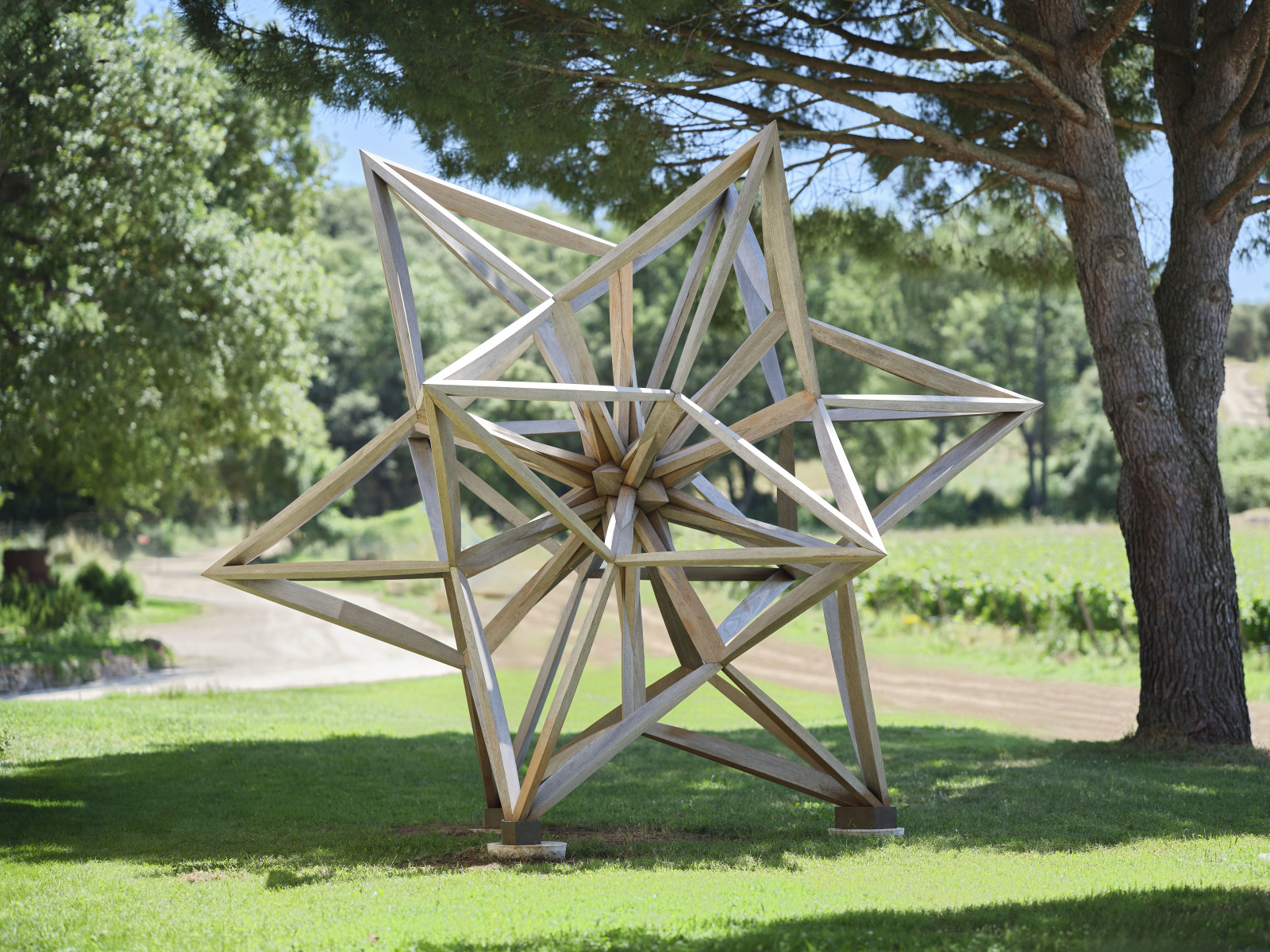Frank Stella
Recent works
July 05 - September 28, 2024
Frank Stella
Recent works
July 05 - September 28, 2024
May 4, 2024. "Frank Stella is dead."
It's 11:30 PM and I receive this text message from a painter friend.
I look at the New York Times page announcing the passing of the man often called the pioneer of minimalism. The great American daily newspaper headlines "master of reinvention." I am deeply moved because I happen to be writing this text, started a few days earlier, about the exhibition of the artist's latest works held over the summer at Domaine de Panery. I realize that the exhibition has now become a tribute. And this text, in between the before and after, a kind of threshold.
I search for images of his Black Paintings, which disrupted the course of art history. Particularly, this vibrant painting of a grid with black and white lines entitled Die Fahne Hoch! in reference to a chilling Nazi song. An abstract piece of course, but with an abyssal meaning that requires no figuration. The narrative naturally flows from the form, which, here, is so powerful. It is a true historical painting, but completely abstract. Unprecedented. This is Frank Stella's artistic revolution in the early 1960s.
Later on, his approach never ceased to challenge the possibilities of extending the original flatness of the canvas. For the artist, a painting wasn't just an image, it was a "working space": the place for all possible transformations and explorations, the place where thoughts are realized, where the symbolic construction of a worldview takes place, if we dare to evoke, a few centuries apart, Leonardo da Vinci’s cosa mentale. Stella's pictorial research pushed formal essentialism to its maximum starting from an initial point: Josef Albers' square, Jean Hélion's cone, Matisse's cut paper, Velazquez's illusionism, Tintoretto's projected perspective... Of course, listing all these revolutionary predecessors might seem like a motley inventory. However, in Stella's case, this enumeration is far from meaningless, because his artistic vision never ceased to question the meaning of modernism and avant-garde in painting, but also the power of formalism. "Formalism" is, in fact, a controversial word, as the 20th-century history of art attempted to fight it in favor of the conceptual, the idea, even the documentary and, more recently, the sociological. However, the question of formal power remains Stella's great interrogation. Like Richard Serra (who died a month before him) in the field of sculpture, Stella succeeded in evolving the notion of flatness towards deeply innovative three-dimensional territories. The almost simultaneous disappearance of these two genius creators seems to signal the end of an era.
Stella made his mark by handling form with such audacity that he probably is the only one to have succeeded in pulling the thread of his lines and minimalist grid towards what he eventually called "maximalism". Much like Italian primitivism gave rise, two centuries later, to baroque extravagances. Some thought it as a change of style, but it wasn’t. It represents an absolute continuity in terms of perpetual "reinvention."
The works of his last years presented in the exhibition are a masterful demonstration of this. Let's first look at the work on paper from the series Illustrations after El Lissitzky's "Had Gadya" from 1985. It could almost be considered a manifesto as it openly refers to the Russian avant-garde artist El Lissitzky, paying direct tribute to his mastery of geometric sobriety while setting it in motion through colorful overlays evoking the rhythm of the traditional Jewish Passover song, "Had Gadya". Stella introduces the motif of the wave, which he reused in his famous series inspired by Herman Melville's novel, Moby-Dick, in which he brilliantly mixed different engraving techniques as well as collages and hand-colored highlights. These aggregates of shapes seem to be an abstract baroque response to the revolution of Paul Cézanne's figurative cubism. A response that reaches its peak in the monumental painting Karpathenburg II from 1996, an impressive pictorial symphony where geometric shapes emancipate themselves from the painting, which, in itself, seems to be a synthesis of all the previous avant-gardes, whether cubism, abstract expressionism, geometric abstraction, lyrical abstraction, etc. Then, starting in the 2000s, Stella’s painting gave way to fascinating and complex volumes, aggregating steel, fiberglass, aluminum, and thermoformed plastic (RPT). Their multicolored swirls intertwine, almost soaring. Inner membranes of a car engine or living organisms? They can be circled around. Painting trophies. Music trophies for the series inspired by Scarlatti's Sonata. Fishing trophies too. Their titles evoking, for some, rivers and lakes in the Gaspésie region of Quebec, where the artist liked to stay. Painting, now turned into sculpture, becomes an imaginary territory that synthesizes the world, in the infinitely large or the infinitely small, with multiple variations. For the artist, it is fundamentally a question of space able to infinitely expand. We also notice the motif of the star increasingly present in these works. The idea of the expanding universe? Especially for his monumental teak star sculpture. “Stella”, let's not forget, means “star”. Minimalist, constructivist, baroque, expressionist, illusionist, maximalist... Stella had no artistic boundaries, except for his loyalty to painting. He was absolutely visionary and has now joined the stars.
Julie Chaizemartin, May 2024.
Artist : Frank Stella
Visitor Information
Ceysson & Bénétière
Domaine de Panéry, route d'Uzès
30210 Pouzilhac
T: +33 6 22 17 14 92



